If you buy through our links, we may earn an affiliate commission. This supports our mission to get more people active and outside.Learn about Outside Online's affiliate link policy
The Best Running Shirts for Men (Fall 2025): Field and Lab Tested
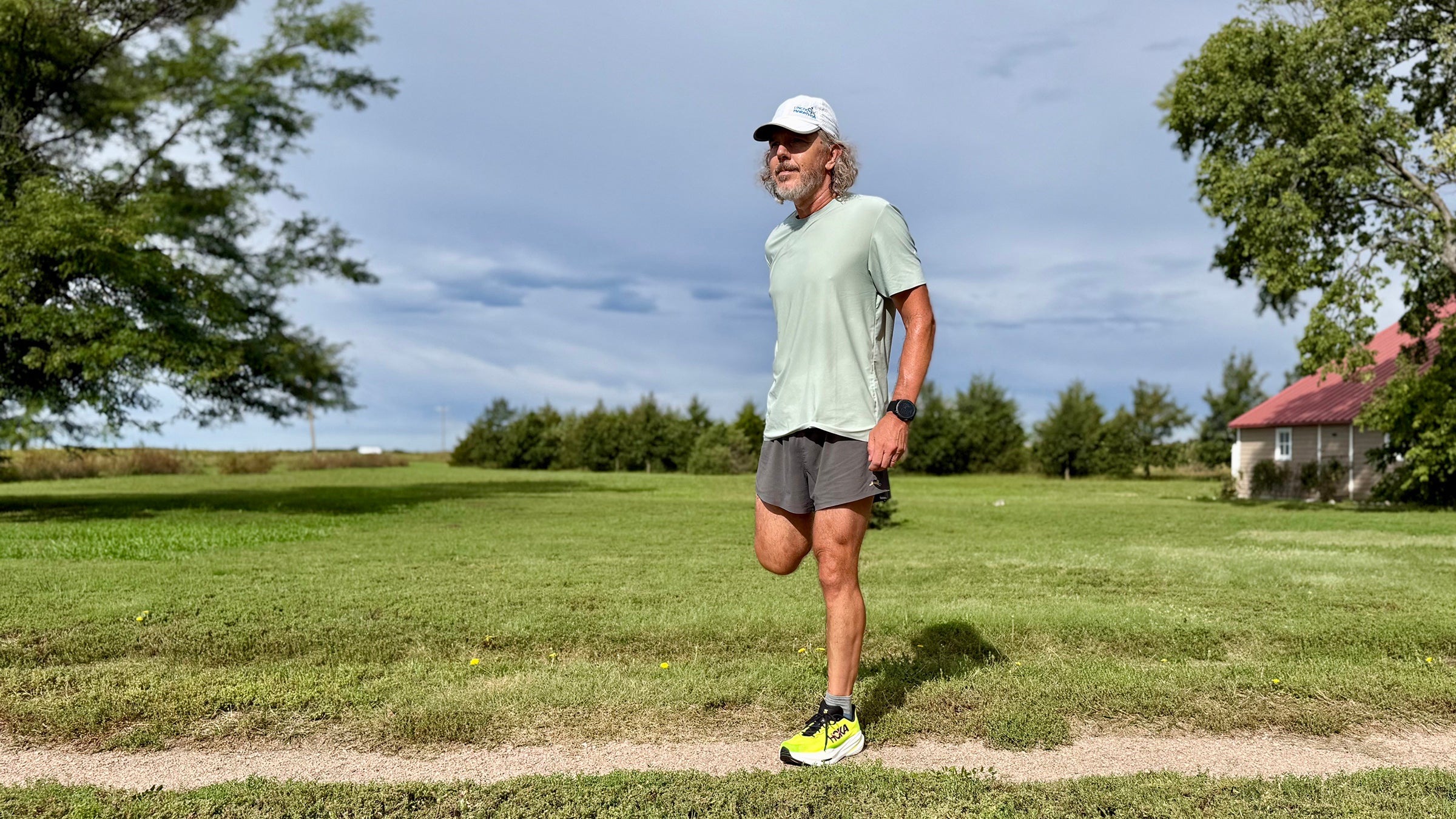
(Photo: Brad Kaminsky)
Table of Contents
As we ease into fall and the temperatures start to dip, delivering some of the best running weather of the year, it’s the perfect moment to reassess your go-to gear, starting with your running shirts.
Whether you prefer a featherlight tank or a warmer short sleeve, the right top can help regulate temperature, reduce chafing, and even give you a mental edge by making you feel fast and ready to rip. To find the best running shirts out there, we tested over 50 short-sleeve t-shirts and tanks to uncover the most eye-catching, top-performing moisture-wicking tops for men.
September 2025 Update: After testing dozens of new running shirts, we named new winners in four categories.
We again called on the Outside Lab for objective lab measurements on air permeability and dry time to help you select the best running shirt for you. Be sure to check out the “How We Test” section below for more details on our methodologies and how to interpret the lab data.
Best Running Shirts: At a Glance
Singlets
- Best Overall: Adizero Running Singlet ($70)
- Runner-up, Best Overall: Hoka Airolite Run Tank ($52)
- Best Splurge: Tracksmith Strata Singlet ($125)
- Best for Race Day: SOAR Race Vest 2.0 ($115)
T-Shirts
- Best Overall: Rabbit EZ Tee SS ($48)
- Runner-up, Best Overall: Path Projects Wadi Tee ($68)
- Best Value: Terignota Trail Tee ($22)
- Best Splurge: SOAR Advanced Tech Tee ($195)
- Best Wool: Smartwool Active Ultralite Short Sleeve ($65)
- Best for High Heat: NNormal Race Tee ($60)
- Best Road-to-Restaurant: Lululemon Metal Vent Tech Short-Sleeve Shirt ($78)
Best Running Singlets
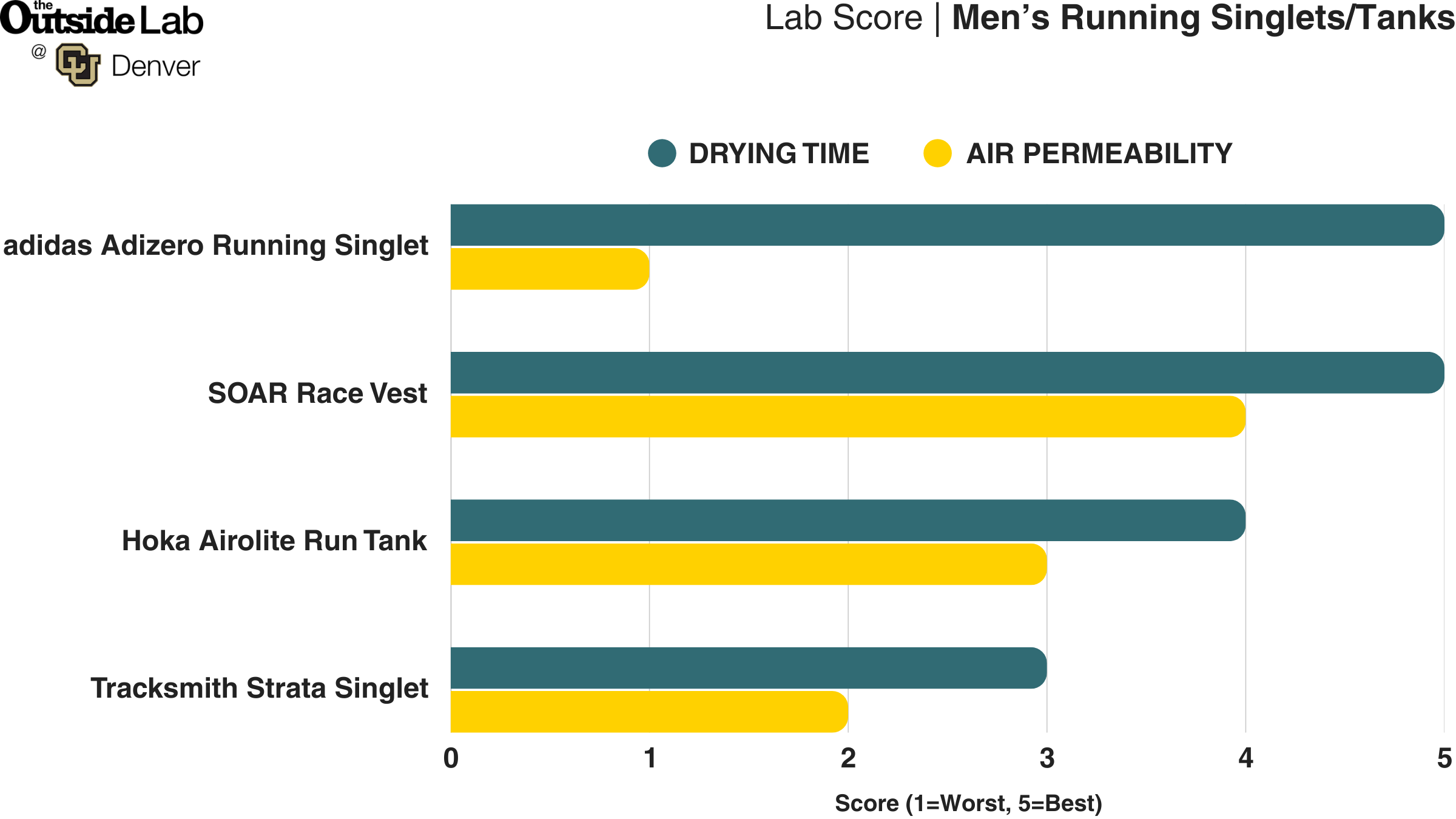
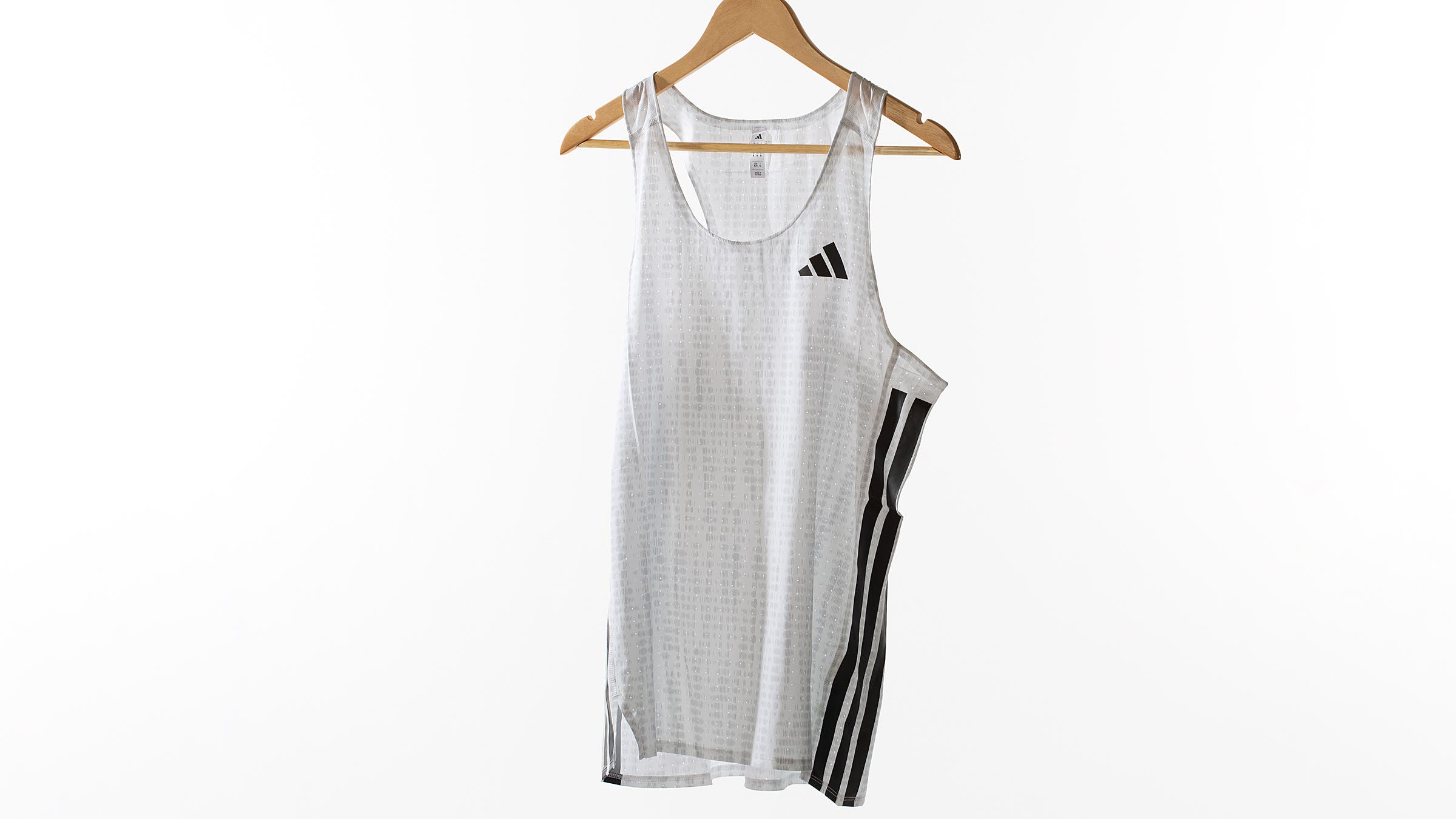
Best All-Around
Adidas Adizero Running Singlet
Sizing: XS-2XL
Lab Dry Time: 5 (1=worst; 5=best)
Lab Air Permeability: 1 (1=worst; 5=best)
Pros and Cons
⊕ Silky smooth feeling
⊕ Superb mobility
⊗ Saturates with moisture easily
There’s something about a light, airy singlet that makes me feel fast. No other singlet captured this sensation better than the Adidas Adizero Running Singlet. Made from a thin, lightweight blend of 86% recycled polyester and 14% elastane, the texture feels phenomenal—smooth and silky, easily moving over the skin. Testers praised its soft touch and barely-there sensation, with one noting it as “the lightest and most comfortable singlet I’ve ever worn.”
The fit is slightly slim, but thanks to the stretchy fabric and side slits in the hem, the singlet offers exceptional mobility. I prefer a slightly looser fit, and my typical men’s medium fit that bill perfectly.
The entire singlet has tiny holes in the face to enhance moisture movement, which helped keep testers cool in most conditions (although the fabric didn’t let much breeze through, according to the lab). Testers’ only negative note was that the fabric tends to stick to the skin when fully soaked through, a common issue among most super-thin shirts tested. This is offset by being the fastest drying of the group, and didn’t keep testers from saying that this stylish, comfortable singlet stood out as one of the best they tested, one they reached for often.
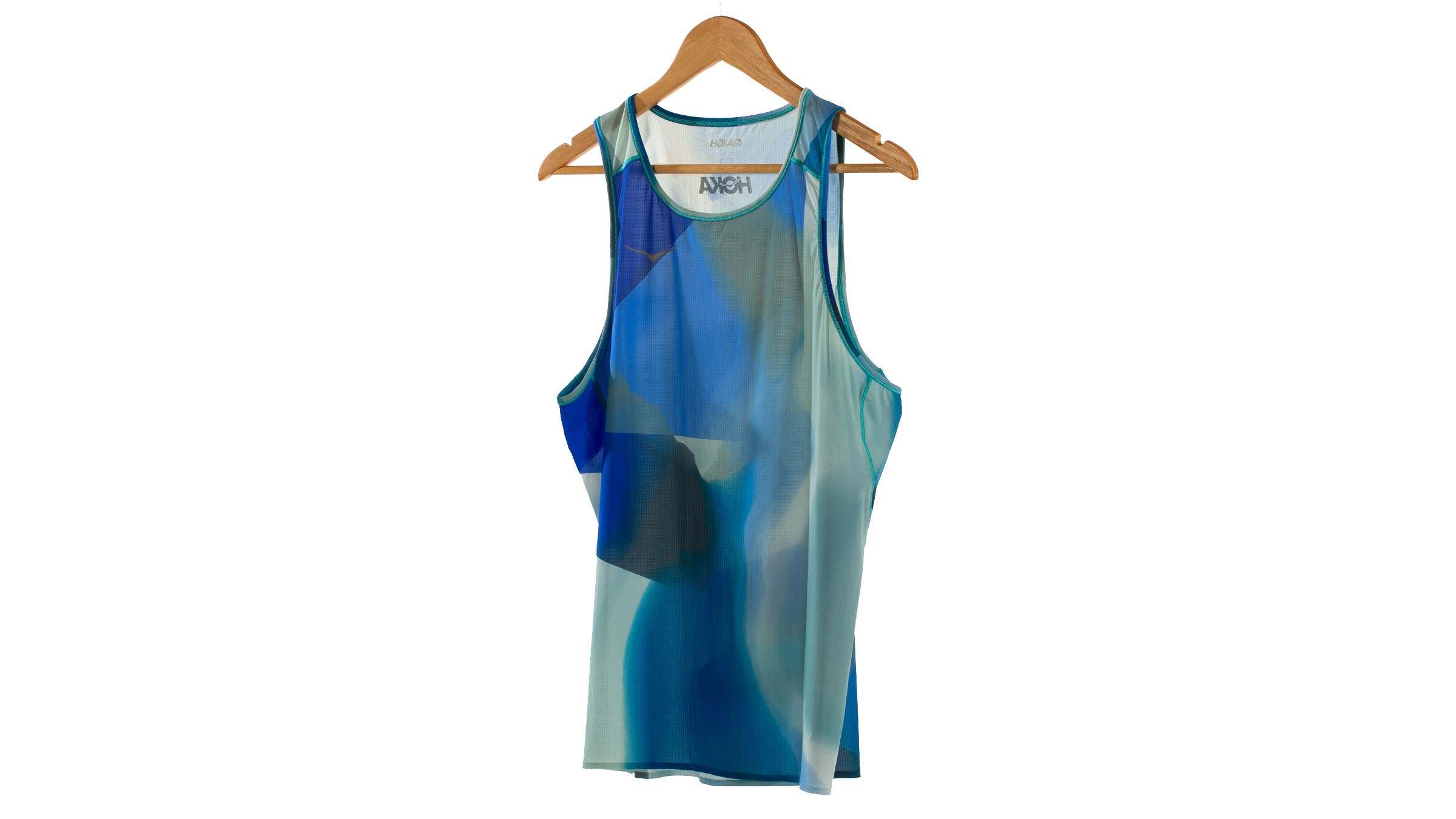
Runner Up, Best Overall
Hoka Airolite Run Tank
Sizing: XS-XXL
Lab Dry Time: 4 (1=worst; 5=best)
Lab Air Permeability: 3 (1=worst; 5=best)
Pros and Cons
⊕ Incredibly light
⊕ UPF 40+ sun protection
⊗ Semi-transparent
With its silky smooth texture and featherlight feel, we found ourselves reaching for the Hoka Airolite Tank time and time again. “I couldn’t find a single thing to ding this tank on—I love it,” raved one tester. Crafted with a pinhole mesh, composed of 72 percent recycled nylon and 28 percent elastane, it was one of the thinnest and most delicate tops we tested, making it disappear on the run.
The featherlight fabric wicks moisture efficiently but can become saturated quickly. However, thanks to its minimal weight, even when it was clingy, it never felt heavy or weighed down. Naturally, its ultra-light design raised concerns about durability. However, after months of wear and repeated washes, one tester was pleasantly surprised by how well it held up.
The tank is “cut is long and slim, with just the right width and length of shoulder straps,” noted a tester. One potential drawback is its semi-transparent fabric, but, despite that, we were pleasantly surprised to discover it offers UPF 40+ sun protection. As an added bonus, it’s treated with an anti-microbial finish—something we didn’t notice in testing but is nice to know it’s there.
With its smooth texture, near weightless design, and added sun protection, the Hoka Airolite Tank delivers on both comfort and performance. While its ultra-thin, see-through design may not be for everyone, those who prioritize weightlessness and freedom of movement will find it hard to beat.
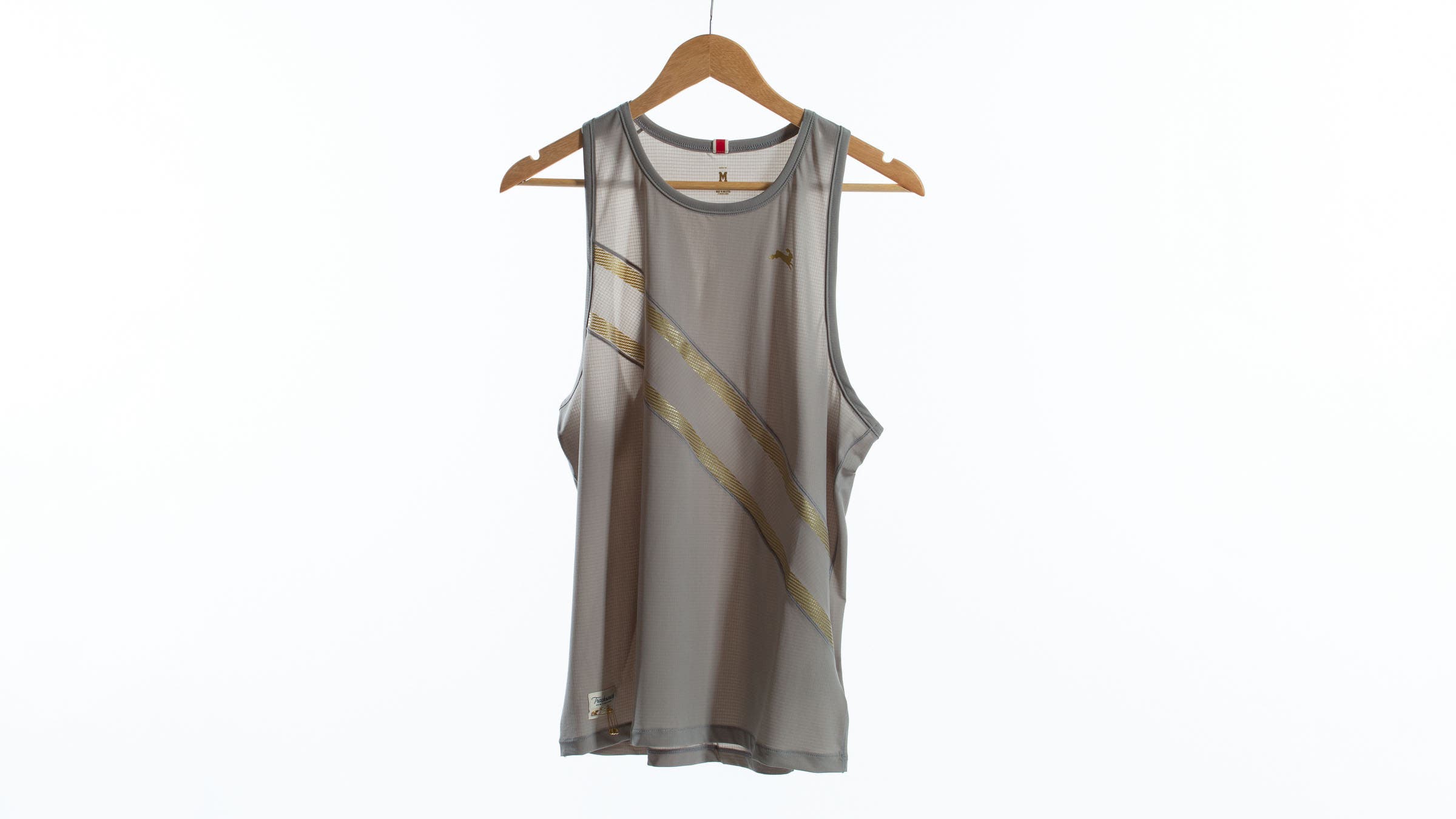
Best Splurge
Tracksmith Strata Singlet
Sizing: XS-XXL
Lab Dry Time: 3 (1=worst; 5=best)
Lab Air Permeability: 2 (1=worst; 5=best)
Pros and Cons
⊕ Unbeatable heat and moisture management
⊕ Odor resistant
⊗ Costs twice as much as many other well-made singlets
Tester Scott Douglas says, “This ultralight marvel is the best singlet I’ve run in during my 40+ years in the sport.” The fit is slim but not restrictive, with plenty of stretch. The bluesign-certified nylon/elastane blend incorporates coldblack, a Schoeller Textil technology that reduces heat absorption like nothing else he’s experienced. As someone who can lose 5 of his 130 pounds on an easy hour run in Maine, he says, “I’m used to wringing out gear post-run and leaving large puddles. This simply wasn’t possible when I wore the Strata; although my shorts and socks were drenched, little sweat had collected on the singlet.”
And then there’s its odor resistance: Douglas ran at least an hour in it every day without washing it during one of summer’s hottest, most humid weeks. “It smelled the same on Day 7 as on Day 1,” he marveled. The Strata is expensive, but a good value, given that owning one eliminates the need for all but maybe one other singlet.
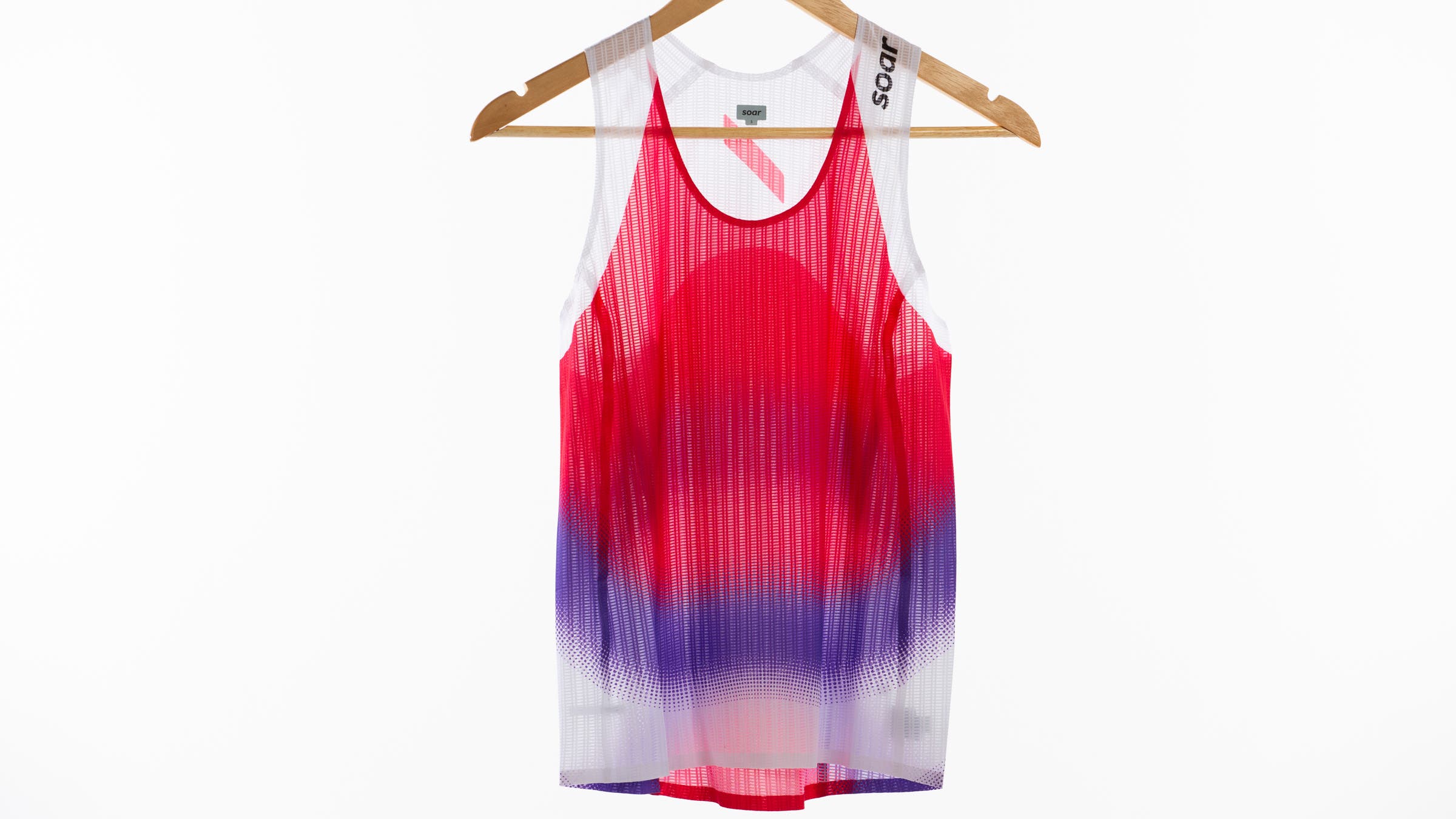
Best for Race Day
SOAR Race Vest
Sizing: XS-XXL
Lab Dry Time: 5 (1=worst; 5=best)
Lab Air Permeability: 4 (1=worst; 5=best)
Pros and Cons
⊕ Extremely breathable, perfect for hot, humid conditions.
⊕ Featherweight design
⊗ Runs small
Displaying the precision and craftsmanship of a top runway fashion design, SOAR’s Race Vest stands at the peak of high-performance running apparel. If you’re looking to turn heads come race day, this is sure to draw attention. “I’ve gotten more compliments wearing this tank than any other singlet,” says lead tester Cory Smith.
The singlet is made with an Italian-made open mesh fabric that’s razor-thin and extremely breathable. Even on the hottest, most humid days, body heat escaped effortlessly, while the airy design allowed any breeze to pass through for cooling relief. The lab confirmed the vest’s airyness: It blew away the field in air permeability and also earned the highest score in dry time.
The only drawback we found was that the fabric doesn’t absorb and wick moisture as well as thicker materials. However, its sheer lightness let skin dry and cool without pulling sweat away from it.
Premium touches like laser-cut and bonded seams eliminated chafing during our test. With many singlets, the shoulders can shift while running, creating a distraction—but not with the SOAR Race Vest. The straps lay flat and stay securely in place. The slim-cut design sits close to the skin and runs small, so if you prefer a more relaxed fit, we recommend sizing up.
Best Running Shirts
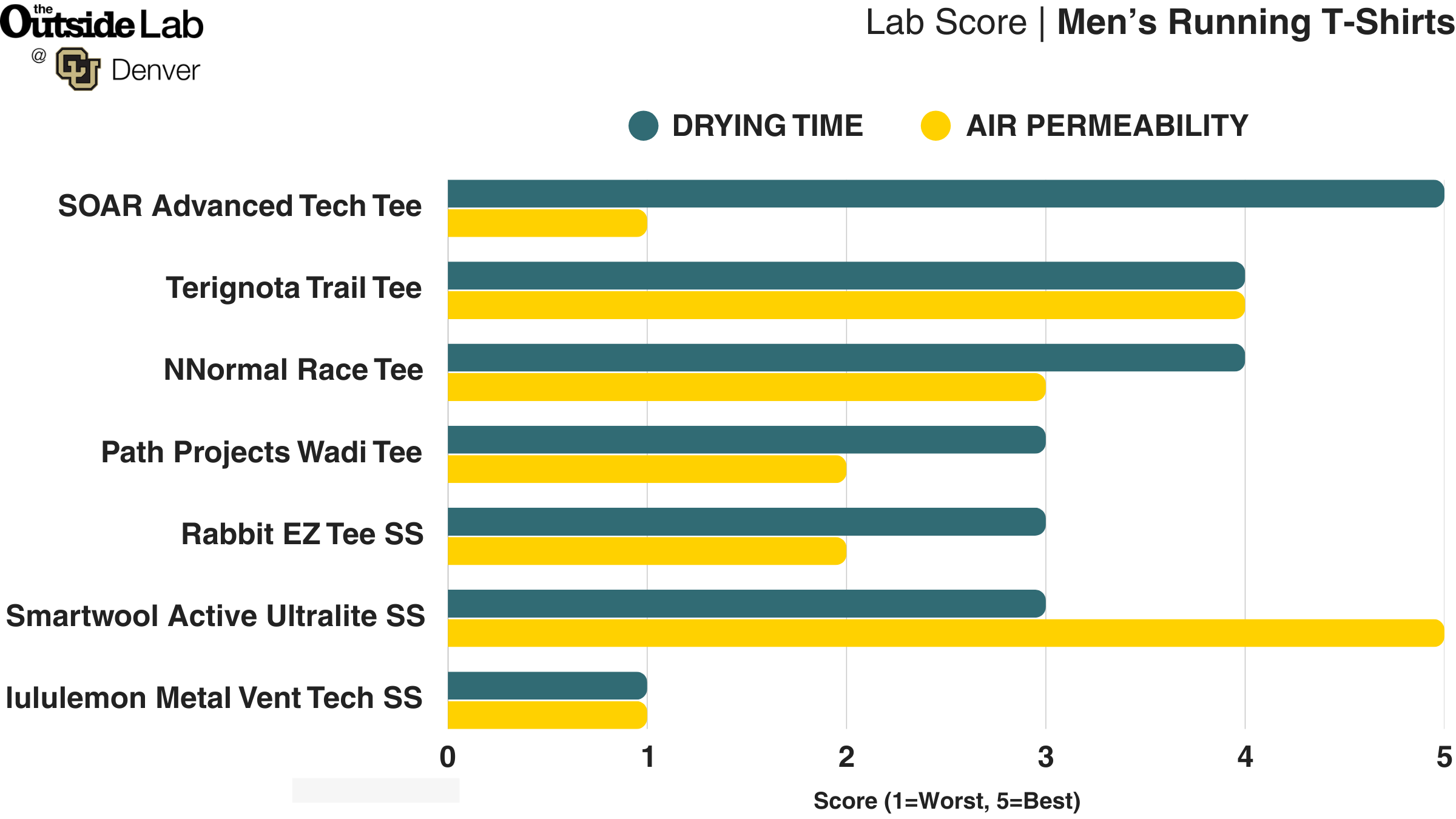
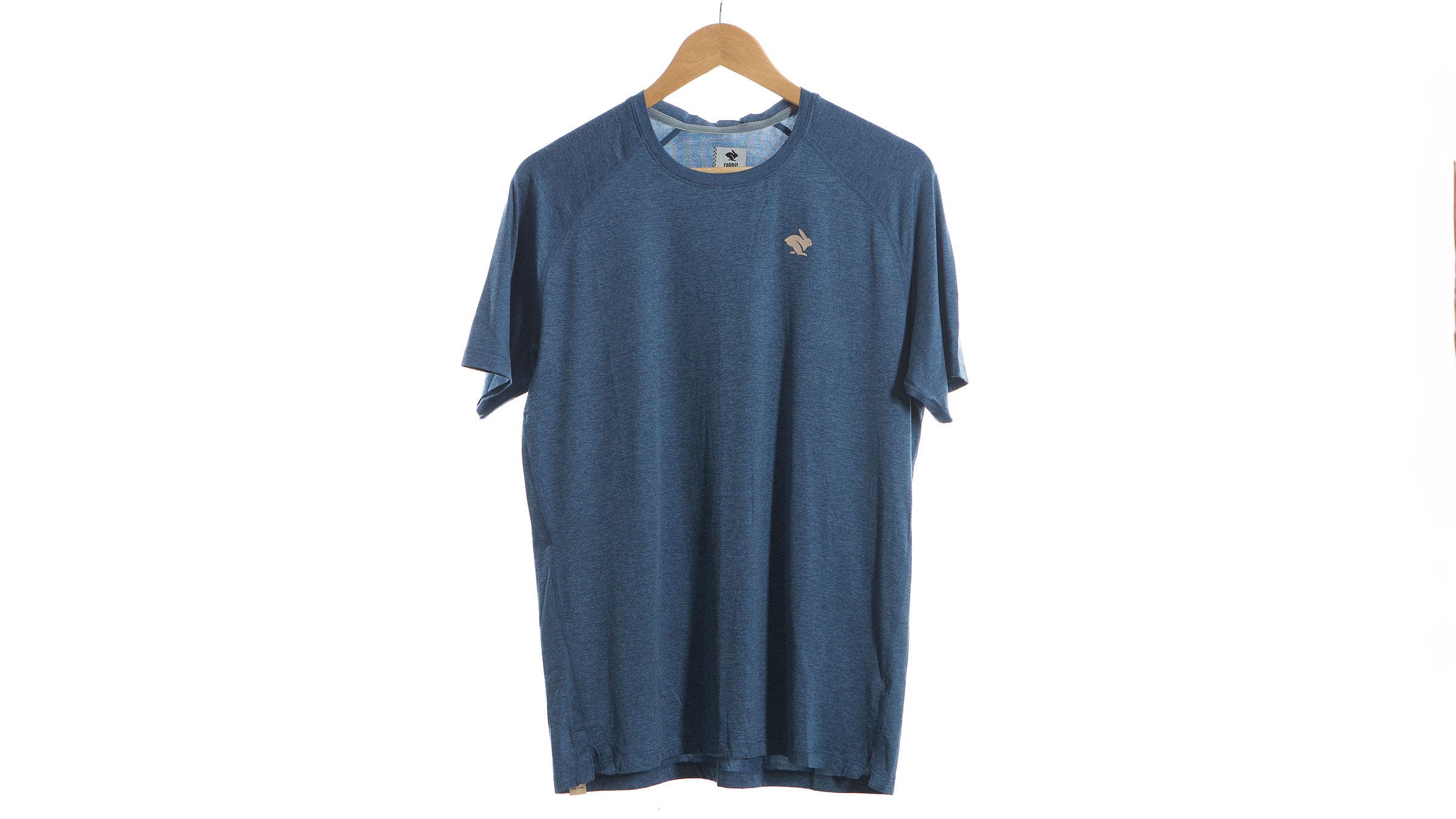
Best Overall
Rabbit EZ Tee
Sizing: S-XXL
Lab Dry Time: 3 (1=worst; 5=best)
Lab Air Permeability: 2 (1=worst; 5=best)
Pros and Cons
⊕ Soft and stretchy
⊕ Flat-lock stitching enhances comfort
⊕ UPF 50 protection
⊗ Below-average air permeability
When we heard Rabbit had updated the EZ Tee, we were a little nervous, as the previous version was just about perfect. Thankfully, the changes are minor, and the shirt retains all the performance qualities of the original. “All the things I liked last year—the long, slim fit and the light, stretchy fabric—are still here, and this is still one of my favs,” said one tester.
Soft, stretchy, and impressively moisture-wicking, the Rabbit EZ Tee takes comfort to a new level. Made with a simple, soft polyester and spandex blend with a UPF 50 rating for sun protection, it’s a shirt you’ll want to keep on post-run, whether you’re grabbing coffee or heading to the gym. It quickly became a go-to for nearly any activity, including everyday wear.
Rabbit says the main update is a new semi-relaxed fit, but when we compared it to the previous version, it felt pretty much the same, which, as one tester described it, was “just right—not too short, too tight, or too loose.” Comfort was off the charts, with a fit that felt neither restrictive nor clingy. Thoughtful details like raglan shoulders and flat-lock stitching highlight the care that went into this shirt’s design.
The one downside, revealed in our lab testing, is that the shirt doesn’t let as much air pass through it as some of the others—a metric known as air permeability. None of our testers called this out as an issue in the field, but it’s worth noting if you prefer particularly airy running shirts.
Maybe the shirt’s most attractive feature? The price. At $48, it’s the best-priced shirt we tested outside of our Best Value winner.
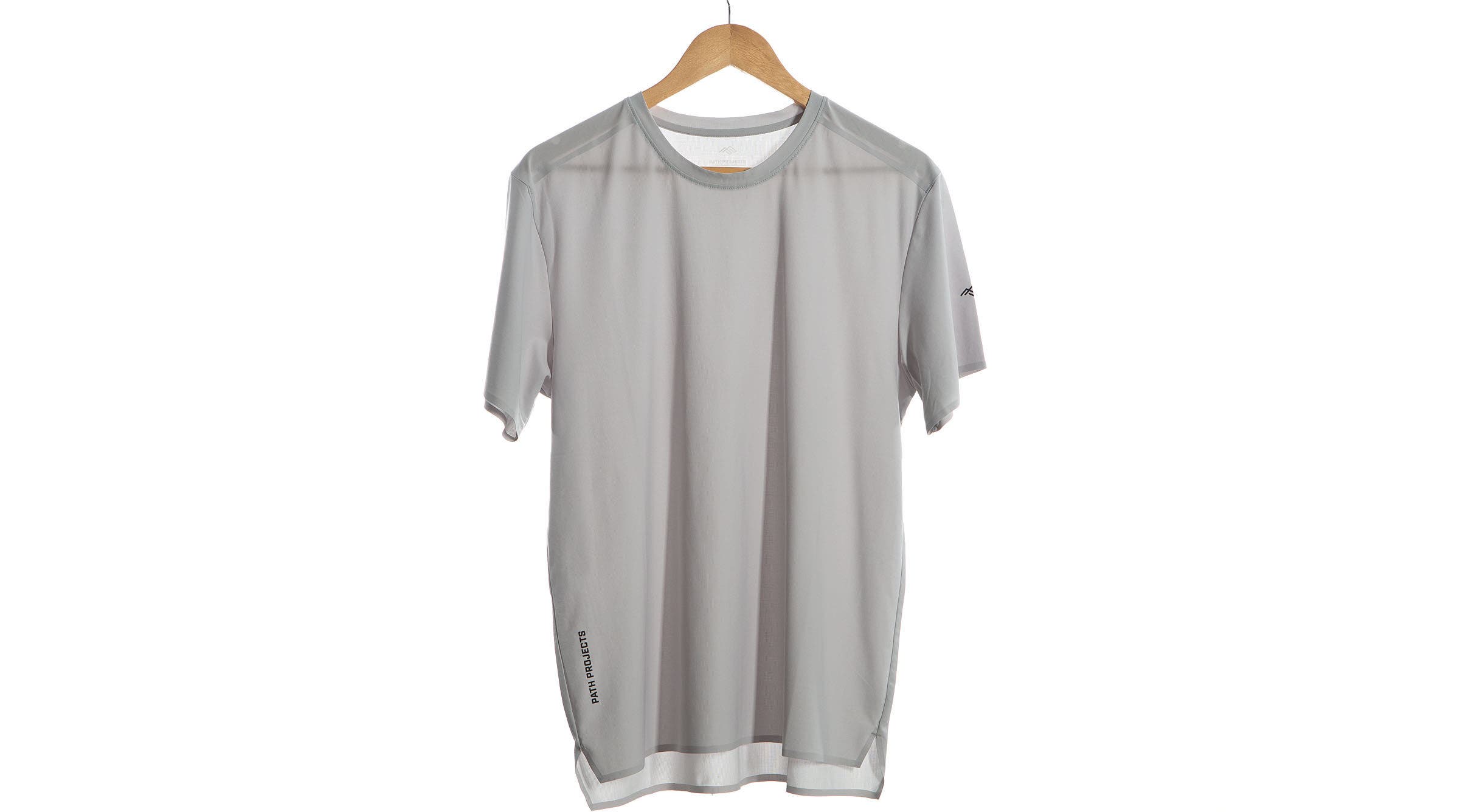
Runner-up, Best Overall
Path Projects Wadi Tee
Sizing: XS-2XL
Lab Dry Time: 3 (1=worst; 5=best)
Lab Air Permeability: 2 (1=worst; 5=best)
Pros and Cons
⊕ Fabric drapes without clinging
⊕ Effective, durable wicking technology
⊕ PFC-free and offers UPF 30+ sun protection
⊗ Slightly heavy on hot days
⊗ Limited to three monotone colors
Path Projects is one of those companies that flies under the radar, but deserves more attention. The Wadi Tee, the brand’s flagship running top, is built with a multi-density knit that pulls sweat away from your skin and moves it to the outer layer. Unlike shirts that rely on topical treatments, its moisture-wicking performance is built into the fabric, so it retains its effectiveness even after repeated washes. It also offers UPF 30+ sun protection while being PFC-free.
Testers praised the Wadi Tee for the way the fabric glides effortlessly with each arm swing. While it’s slightly heavier and retains more sweat than some of the other shirts we tested, many appreciated its soft, silky smooth texture, especially as the peak summer heat started to fade and sweat became less of an issue.
One taller tester noted that the hem sits slightly too high on the waist, but most found the Wadi Tee to fit well overall, though the fabric offers limited stretch, making it important to get the sizing right. The only other critique was the limited color selection, with mostly monotone options available.
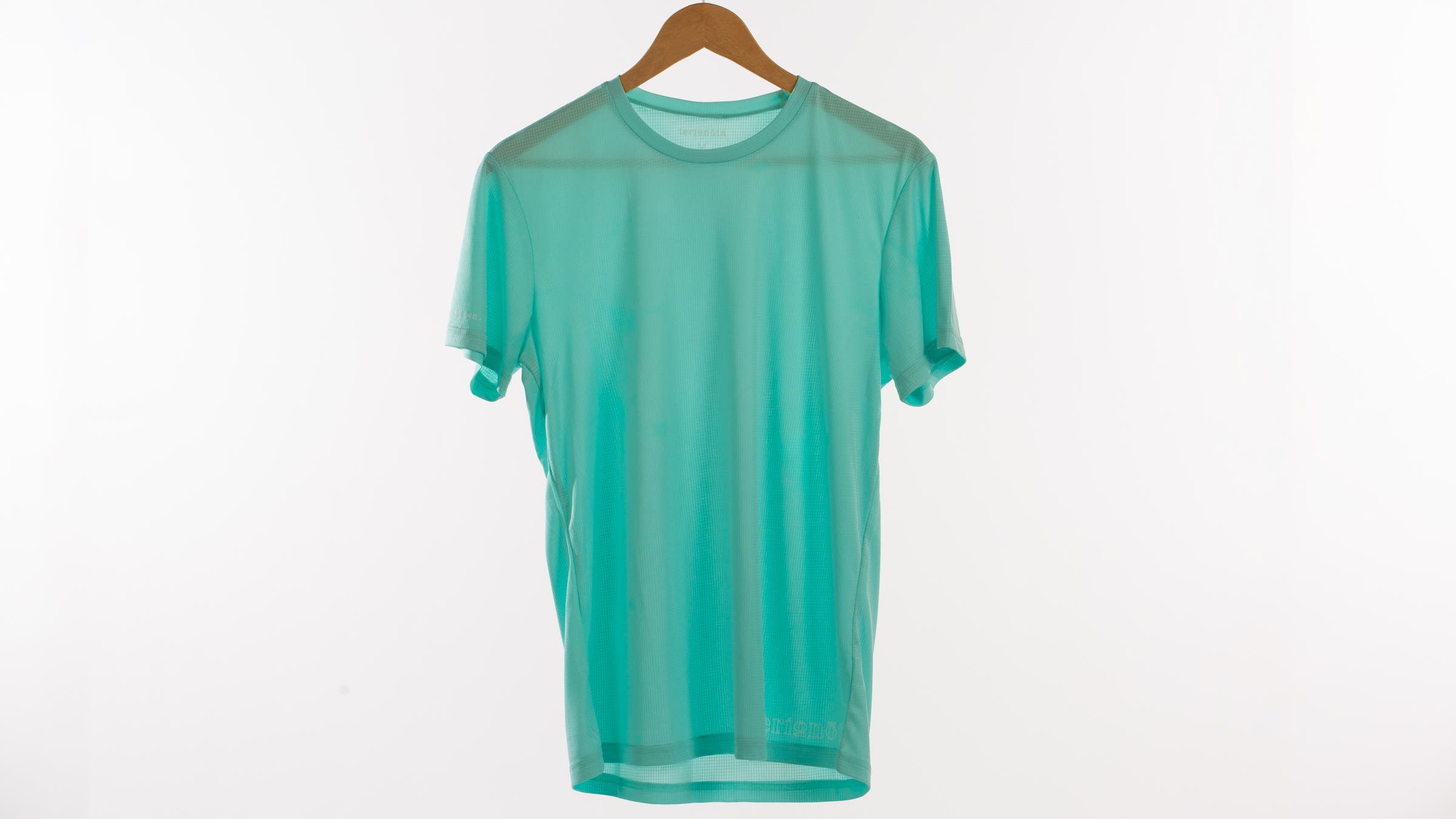
Best Value
Terignota Trail Tee
Sizing: XS-XXL
Lab Dry Time: 4 (1=worst; 5=best)
Lab Air Permeability: 4 (1=worst; 5=best)
Pros and Cons
⊕ Extremely lightweight
⊕ Outstanding price-to-performance
⊗ Limited color options
At nearly a third of the cost of other shirts, simply put, you will not find a higher quality shirt at a better price. Crafted from 100% polyester with a woven grid pattern, it checks all the boxes: lightweight, breathable, and comfortable. Its woven design and thin fabric reminded me a lot of Patagonia’s Capilene.
Despite being called out as a trail tee, it’s equally suitable for the roads. Throughout the warm, sunny SoCal summer, it kept me cool and comfortable, proving to be a versatile go-to for any run. After hot and sweaty runs, I was impressed with how quickly the shirt dried in direct sunlight. The lab bore this out: It had the second-fastest drying time among running shirts we tested.
The fit is labeled as relaxed, but I found it slightly on the slim side compared to other shirts tested. Not enough to size up, but I wouldn’t call it a true relaxed fit.
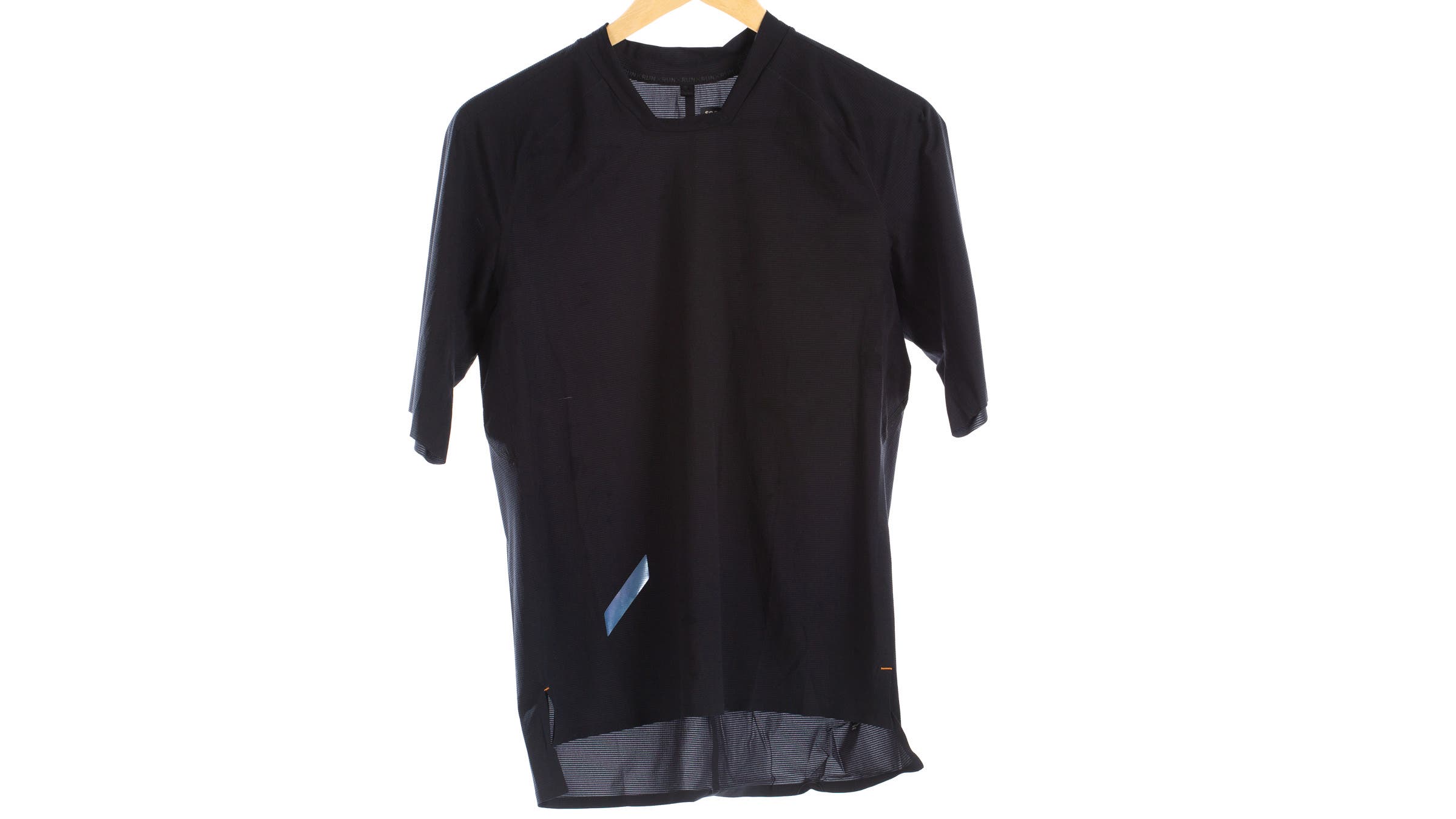
Best Splurge
SOAR Advanced Tech Tee
Sizing: S-XXL
Lab Dry Time: 5 (1=worst; 5=best)
Lab Air Permeability: 1 (1=worst; 5=best)
Pros and Cons
⊕ Fantastic range of motion
⊕ Extremely breathable
⊗ Short hem length
London-based SOAR founder Tim Soar says he incorporates his passion for functionality, performance, and sports science into every design, and the Advanced Tech Tee is a prime example of this.
At first touch, the ultralight, stretchy 3D woven fabric felt “a bit stiff and scratchy,” according to one tester. But that impression didn’t last long. “It disappeared once I started running,” he said. “I actually feel cooler and more comfortable in this than going shirtless.” The fabric’s subtle stretch and textured weave made it stand away from the skin and stay dry, even when we were sweating profusely. Surprisingly, the lab reported that the tight fabric doesn’t let much air through, but it has the fastest dry time of any shirt or singlet tested, quickly evaporating moisture.
Additional touches, such as a split hem and one-piece raglan sleeves, enhance freedom of movement, while laser-cut sleeve hems and flat-locked seams reduce potential chafing.
The tee boasts a relaxed fit but leans more toward a European cut—slightly fitted through the shoulders and chest, with a bit more room through the torso for ease of movement. My only wish is that the hem was a little longer to better accommodate those with longer torsos who prefer more coverage.
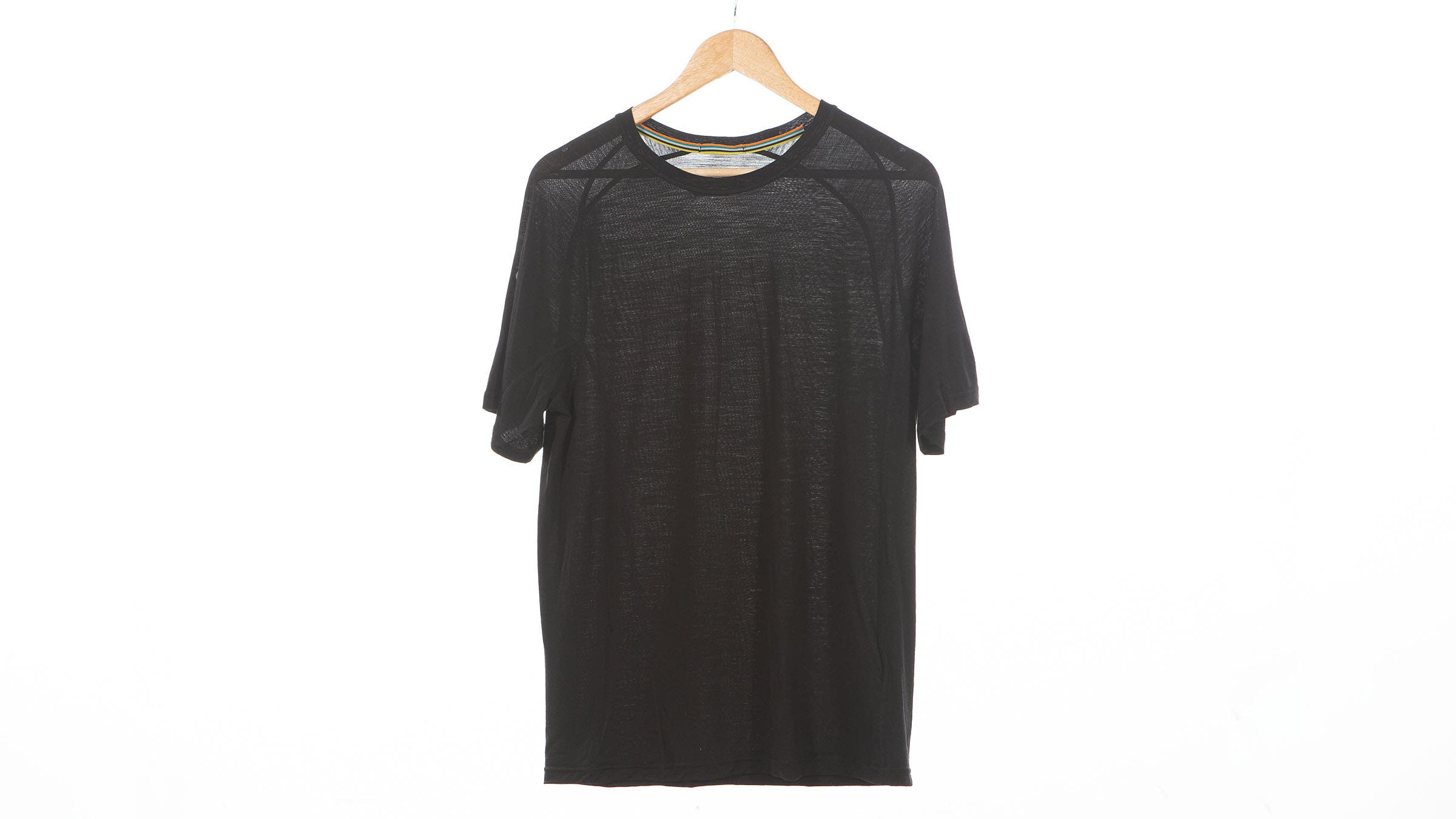
Best Wool
Smartwool Active Ultralite Short Sleeve
Sizing: S-XXL
Lab Dry Time: 3 (1=worst; 5=best)
Lab Air Permeability: 5 (1=worst; 5=best)
Pros and Cons
⊕ Fabric is thin and highly breathable
⊕ Wicks and dries moisture exceptionally well
⊕ Soft, natural feel against the skin
⊗ Delicate care is required
When it comes to wool apparel, Smartwool remains a trusted leader. The Active Ultralite Short Sleeve stands out as their highest-performing tee for high-output activities like running.
The shirt is made with 53% Merino Wool and 47% Tencel Lyocell fiber, a blend that absorbs moisture faster and has higher thermal conductivity than merino alone. It also adds durability and is more eco-friendly. During testing, we can attest that the Active Ultralite Short Sleeve felt breezy and cool, and when sweat did start to drip for our pours, it absorbed it well.
The fabric’s extremely light weight contributes to this being one of the more comfortable wool shirts we’ve tested in hot and humid conditions—and it scored the highest of the test group in air permeability. It does, however, require some extra care in laundering: one tester intentionally threw it in with other clothes all summer and noted some thinning spots after multiple washes.
The cut is athletic, designed to follow the natural lines of the body without being tight or clingy. “The fit was both the most comfortable and stylish of all the shirts I tested,” said one tester. Another said he fell between sizes and chose to size up for a more relaxed fit, which he appreciated.
The shirt displayed all of wool’s famed anti-odor properties. We had no problem getting multiple wears out of the Active Ultralite without the usual post-workout stench, which made this a go-to tee for travel as well as daily runs.
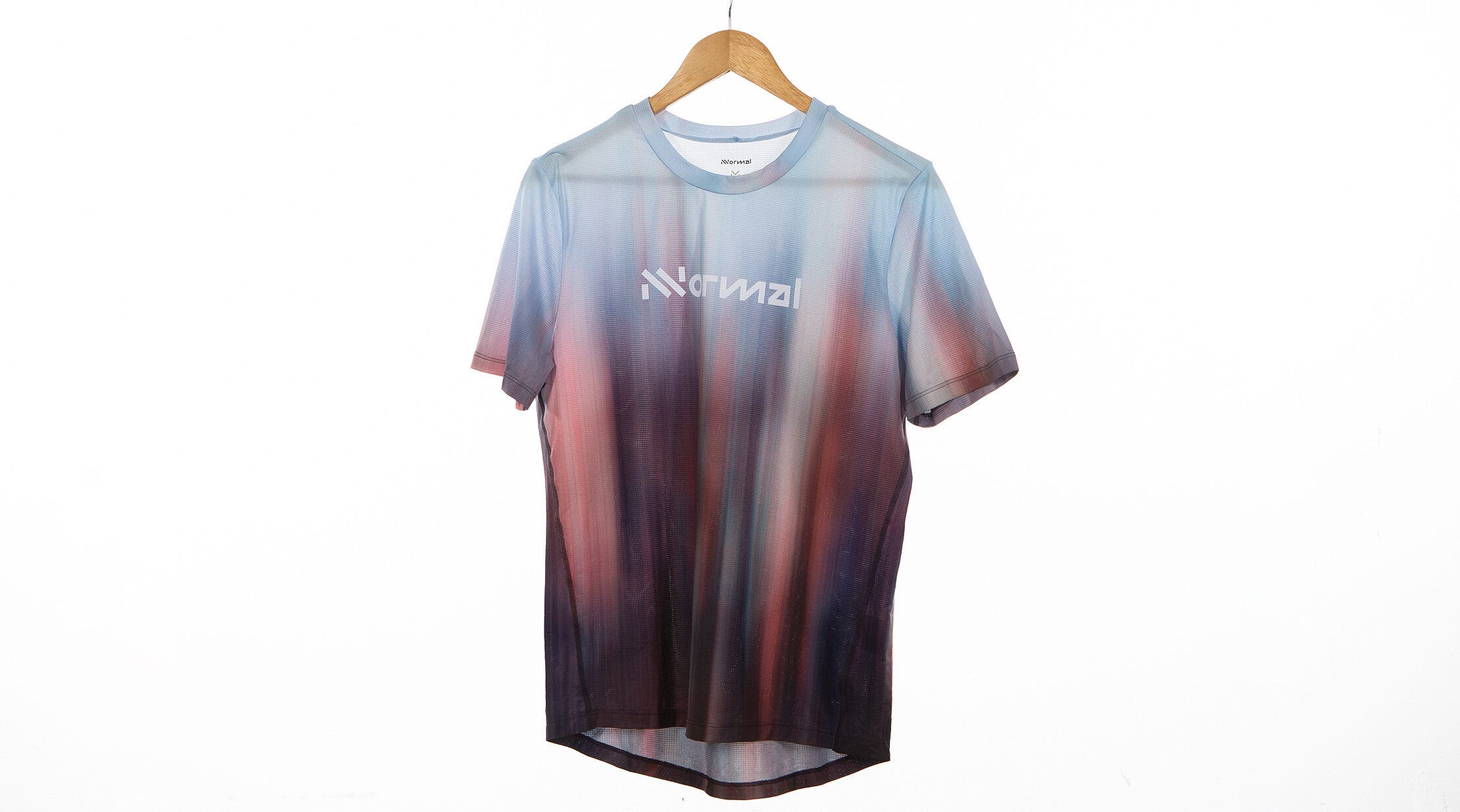
Best for High Heat
NNormal Race Tee
Sizing: XS-XL
Lab Dry Time: 4 (1=worst; 5=best)
Lab Air Permeability: 3 (1=worst; 5=best)
Pros and Cons
⊕ Extremely lightweight and breathable
⊕ Fast drying time
⊗ Light colors are see-through
The NNormal Race Tee quickly earned a place as our go-to shirt when the air was so thick and heavy that it felt like we were running through soup. One tester raved, “It’s so lightweight you barely feel like it’s there. It absolutely shone in terms of breathability.” Made from ultrathin recycled polyester and elastane, the open-knit construction allows excellent airflow, quickly wicks sweat off the skin, and dries rapidly.
The fit leans towards a slim athletic cut, so size up if you prefer a more relaxed, flowy fit.
One trade-off with such a sheer shirt is that the lighter colors can be see-through. If that’s a concern, opt for darker shades that are more opaque. Testers also noted the fabric feels delicate. While that’s great for breathability, it raised questions about long-term durability, although we didn’t notice any tears or runs during the test period.
For humid runs, heat-wave workouts, and hot races, the 2.5-ounce Race Tee was an easy pick.
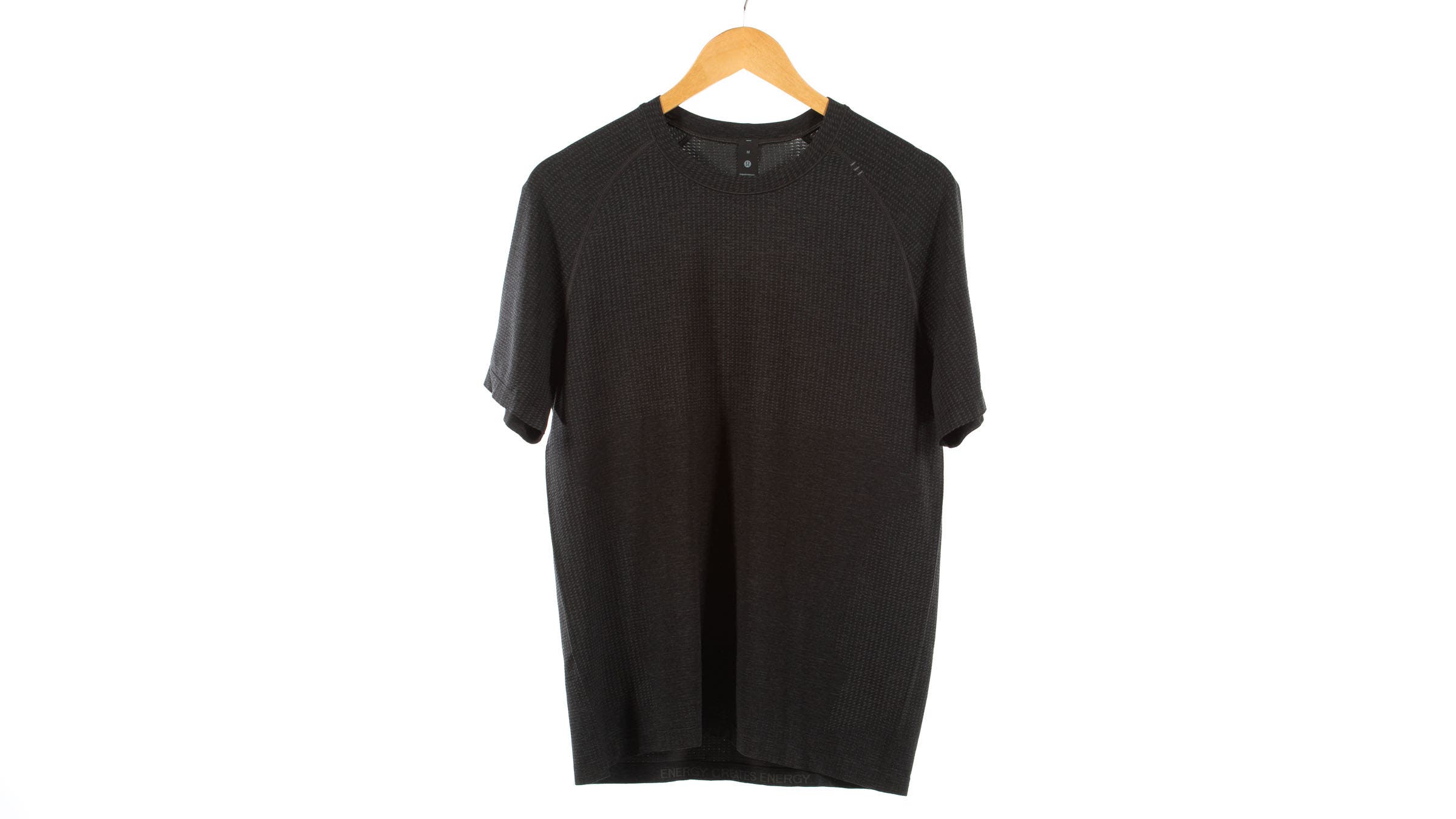
Best Road-to-Restaurant
Lululemon Metal Vent Tech Short-Sleeve Shirt
Sizing: XS-XXL
Lab Dry Time: 1 (1=worst; 5=best)
Lab Air Permeability: 1 (1=worst; 5=best)
Pros and Cons
⊕ Superb range of motion
⊕ High-quality fabric
⊗ Not as good at dealing with heat as lighter, more breathable fabrics
Best suited for runs that start at the track and end at the cafe, the Lululemon Metal Vent Tech blends performance and style with a timeless, refined design. “It seamlessly transitions from morning runs to evening restaurants with uncompromised excellence,” one tester reported. Made from a nylon, recycled polyester, and elastane blend, this shirt has a heavier, more substantial feel than the thinner options we tested. It doesn’t vanish like ultra-lightweight running shirts but instead offers a noticeably soft and comforting feel against your skin.
While it’s not a particularly airy shirt, we found it does breathe and wick moisture adequately to not feel clammy on most days. And, thanks to the built-in stretch, the shirt offers an unrestricted range of motion and doesn’t hold you back on the run. On extremely hot days, however, when sweat is pouring and the fabric becomes fully saturated, it can feel slightly weighed down.
Given its versatility and comfort, the Lululemon Metal Vent Tech became one of our go-to shirts for just about any occasion, from running to lounging at home to heading out for a casual dinner.
What to Look For in Running Shirts
Dressing for running is straightforward—you want pieces that breathe, wick moisture, move naturally, don’t stink, and don’t get in the way. Shirt choices come down to how much skin coverage you prefer, fit, and material.
Here are some quick tips on buying the best running shirts without going broke:
- Look for high-quality synthetic fibers. Yes, our top picks include a few items with natural fibers. But for the most part, specially designed varieties of polyester, polyamide, nylon, and the like can handle running’s sweat rates better than wool and cotton.
- Seek sun protection. Even if you run at dawn or dusk, or on trails, sun damage can be insidious. Many shorts and tops come with a UPF coating. Well-ventilated hats reduce squinting while shedding heat. Running tan lines aren’t something to be proud of.
- Check for chafing. If you’ve ever been rubbed raw by a rigid seam or sagging liner, you won’t want to repeat the experience. Abrasion accelerates when you’re drenched in sweat. Look for flat seams, unobtrusive logos, and other elements of construction that will minimize chafing.
- Go with the flow. Our picks in this review strike the right balance between being loose enough to allow cooling air flow but not so billowy that they impede normal running form.
- Banish bacteria. Many high-quality running running shirts incorporate an anti-bacterial treatment that greatly reduces nasty odors setting up shop. These pieces not only can be worn many more times before needing to be washed, but also lessen your chance of developing a funky skin situation.
- Invest in quality. It can be tempting to think, “Whatever I run in is going to get soaked anyway, so I’ll just buy the cheapest gear out there.” Such reasoning quickly falls apart when, well, the item itself starts to fall apart because of constant exposure to sweat and frequent laundering. Fewer high-quality pieces that hold their form and don’t hold odors are better than more cheaply made gear that will start disintegrating in one summer.
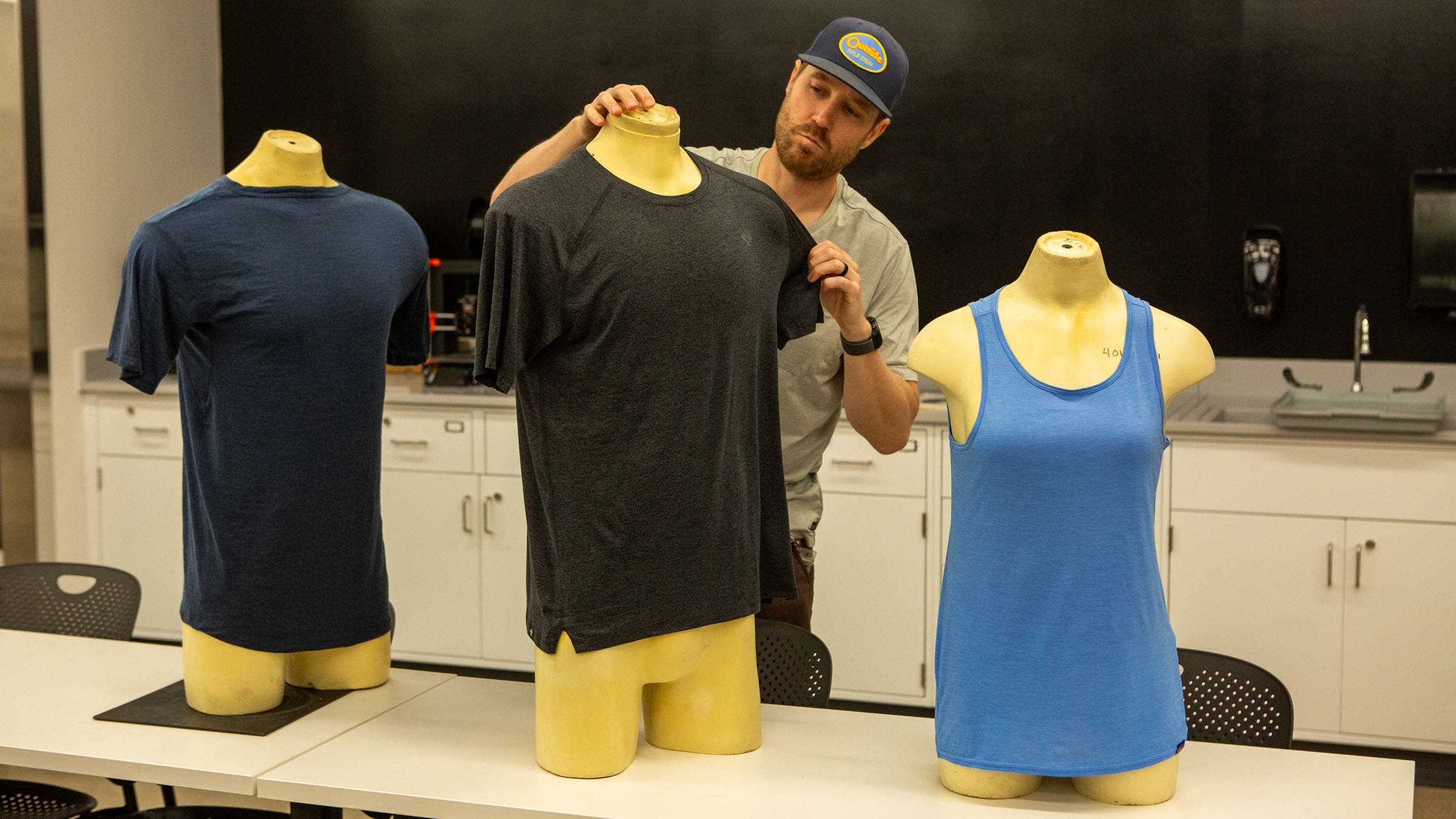
How We Test Running Shirts in the Field
- Number of testers: 10
- Number of products tested: 20+ singlets, 40+ short sleeve tees
- Number of brands tested: 45+
- Number of miles run in testing: 4,500+
- Highest testing temperature: 101°F
Our testing team ranged across the U.S.—from the California beach town of Santa Barbara to central Wisconsin and the high plains of Nebraska, to the urban bake sites of Chicago and Houston, and, for good measure, the running hub of Eugene, Oregon. All are dedicated runners with average weekly mileage ranging from low 20s to mid-70s over both roads and trails. Some have been running for 30 or more years and can compare today’s running apparel to previous attempts to keep runners cool in the summer. We focused on a subjective combination of moisture management, comfort, versatility, value, and looks to answer a simple question: Of all the apparel you logged summer miles in, which would you be most likely to recommend to fellow runners?
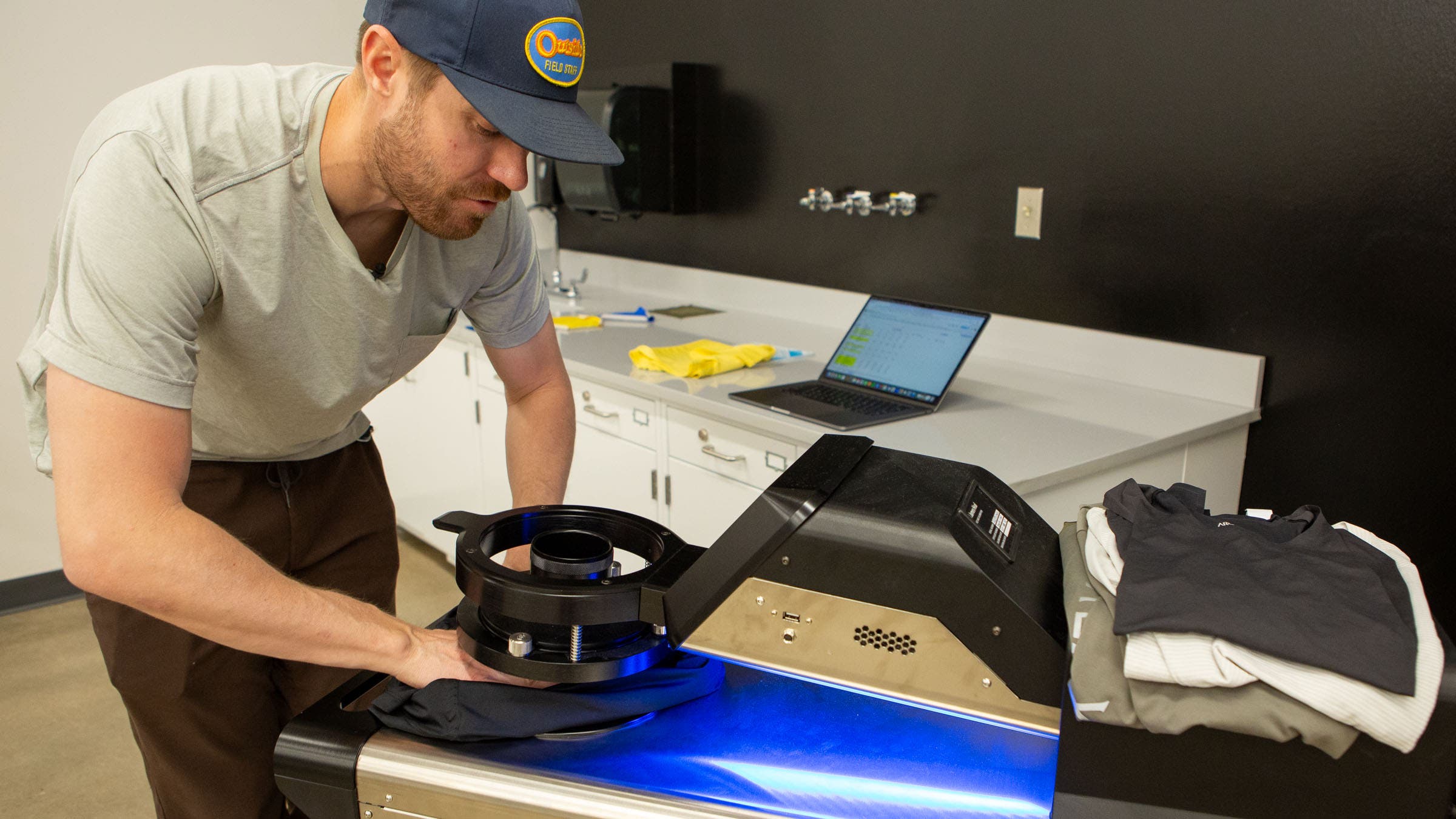
How We Tested Running Shirts in the Outside Lab
Air Permeability
Air permeability is a measure of how much air (in volume) is able to move through a fabric. It is not the same as “breathability” which measures how moisture vapor (sweat) moves through a fabric. The more air permeable, the more the cooling breeze makes it through your shirt and reaches your skin directly. To test this in the Outside Lab @ CU Denver, we use a James Heal AirPro, a machine that uses a vacuum pump to pull air through fabric clamped between plates with a specific diameter opening to measure the flow rate at a pre-set pressure. The greater the volume of air getting through, the more air permeable. This lab test only evaluates the material itself, and can’t account for how the cut and design of a garment aids its airiness.
Dry Time
The lab tested drying time by soaking each shirt and then recording how long each needed to dry. Each shirt was weighed while dry, then soaked in tap water until all of the material had absorbed water. After soaking, they were hand wrung until all excess water stopped releasing from the fabric, leaving a fully saturated, but not soaked, shirt. The saturated shirts were weighed again to get the “wet” starting point and then put on a mannequin to dry. Weight was recorded every hour to start and then every 15 minutes as they approached dryness, stopping when the sample was within 4 percent of the original dry value. Allowing for 4 percent of weight gain (a few grams) takes into account any dirt particles that could be introduced from the tap water or environment, and small hemmed areas of the shirt that may hold a little moisture, even though the overwhelming majority of the shirt is dry.
We compiled the raw data into groups of similar values for each measure to obtain scores of 1 to 5, worst to best, relative to all the t-shirts and singlets tested.
Meet Our Lead Testers
Cory Smith
Cory Smith, a former Division One runner at Villanova University, has been running since the mid-1990s. With over a decade of experience testing and reviewing running apparel and shoes for publications like Outside and Runner’s World, he continues to compete as a masters athlete, boasting a personal best of 4:31 in the mile. He consistently logs 30 to 40 miles per week over roads, trails and on the track.
A 13.25km trail race Cory Smith ran while testing the Adidas Adizero Running Singlet.
(Gaia GPS is owned by Outside Inc.)
Scott Douglas
Scott Douglas says, “I’ve run more than 130,000 miles since starting as a teen in the 1970s, and have always loved how daily runs undergird and elevate the rest of my life.” The author or co-author of several running books and a writer/editor about fitness, he sweats like crazy despite living in Maine.
Other testers included:
- Jonathan Beverly, a Nebraska resident who is a senior running gear editor for Outside and has also been running since the 1970s.
- Nathan Brown, a doctor of physical therapy who founded the Pineries Running Lab in Wisconsin.
- Brock Butler, a former NCCA Division I runner and teammate of our lead tester, Cory Smith.
- Jason Brozek, a trail runner and ultra-marathoner who lives in the tundra of northeastern Wisconsin.
- Brandon Birdsong, a 2016 Olympic Marathon Trials qualifier, also holds personal bests of 29:54 10k and 1:04:21 half marathon.